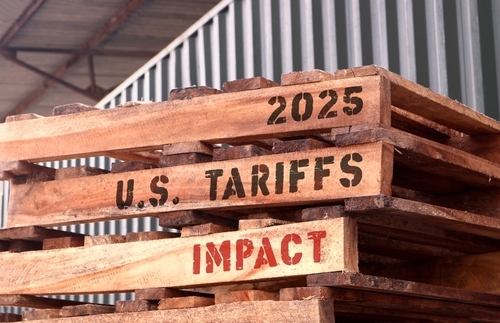Landstar uses wireless technology to increase retention of its driving fleet THE STEREOTYPE of a rough-and-tumble truck driver living the solitary life on the road isn’t what one would call high-tech. But drivers for Landstar System Inc. are far from being disconnected on the lonesome highway.
The Jacksonville, FL-based company was one of the first transport and logistics firms to use the Internet to post available freight and other critical data to its business capacity owners (BCOs, otherwise know as truck drivers) right in the cabs of their trucks via laptops. Now they’ve taken that a step further by offering wireless options.
These days, the 7,200 independent contractors – the foundation for Landstar’s $1.5 billion business, hauling just about everything from industrial cranes to life-saving heart valves – can dial-up Landstar’s Web site via cell phones, personal digital assistants, palm pilots or other Web-enabled handheld devices.
The company’s Web site, which was launched in 1997, was a boon to BCOs as they could log on, find out what type of loads were available and where; what the job was worth; get directions; let Landstar know that the freight reached its destination; check their debit card balance; say if they needed new tires; find out the location of cheap fuel; get weather reports and the like. Trouble was, you needed a PC or a laptop. Laptops can be expensive and when you’re on the road, accessing a PC often meant phoning home or to a business partner and having them go online to gather the information. Inconvenient to say the least.
“With the Internet site, we overcame the time-consuming process of BCOs having to work through a sales agent to access the database in order to find an available load,” says Patrick Wise, vice president of e-commerce for Landstar. “And yet, as robust as our Web site is, there are still limitations due to the sheer nature of this business.”
Landstar had been looking at wireless data technology for a couple of years, watching the trends and looking for the right partner. Then came a cold call from PhoneOnline.com, the Knoxville, TN-based software services and solutions company that specializes in the wireless mobile Internet.
The goal was clear: to create a way to exchange accurate information to and from business partners in a safe, timely, easy-to-use, cost-effective manner. Since most of the BCOs already had cell phones, wireless seemed like a cost-efficient way to solve the problem, says Bob Leo, director of professional services for PhoneOnline.
But creating a solution involved much teamwork – on the part of PhoneOnline and Landstar staff and executives – to hash out what was needed for the BCOs to do their jobs most effectively. After a favorable pilot test with 30 drivers, the new system was fully implemented in September.
“It’s hard to say whether Landstar is the first to do what it is doing, but it may very well be the first to go this far,” says Tom Gelinas of Fleet Equipment magazine, Palatine, IL. “Wireless is being used in the industry, especially cell phones.”
Keeping the drivers is a primary goal for Landstar. BCOs are independent and could work for anyone. Like other industries, there’s a shortage of people to do the work.
“It’s a tough life,” says Wise. “People live on the road, shower in truck stops and have to be away from their families.” In addition, the rise in fuel prices has made it sometimes more cost-effective for the BCOs to park their trucks and do construction, he adds. Retention and recruitment is an industrywide problem.
And, Leo points out, “anything that saves BCOs time and money goes a long way toward creating a one-to-one, sticky relationship. The longer they stay, the better off Landstar is.” Leo sees it as a potential recruiting tool as well. “Say a driver is eating his dinner and punching in the numbers on his phone looking for his next load. Other drivers might ask what he’s doing. Once he explains what Landstar enables him to do, well, that’s a selling point for Landstar.”
The new system should help nurture that relationship. “The BCOs now have better access to timely information that will likely make them more profitable as they can work smarter, versus longer and harder,” says Wise. Also of much importance is the quality-of-life issue. “With improved accessibility to information, people can better plan their loads. Just maybe they’ll be able to get home for their son’s birthday,” he adds.
The drivers aren’t the only ones who benefit from the new system. “If the BCOs work more efficiently it pays off for them and us,” says Wise. “And if we reap the recruiting and retention benefits that we expect, there’s an immediate enhancement to our bottom line – it hits it like a rock.”
One ongoing issue is limited coverage. For now, the technology works best in and around large metropolitan areas in the East, West, Southwest and some spots in the Midwest. Landstar is looking into how to increase coverage.
What’s the ROI for Landstar? “It makes no sense to do a return on investment given the low cost of the program – $250,000 when you look at the potential economic benefits,” says Bob Luminati, executive vice president and chief information officer. I’m anticipating a 10, 15, or 20 to 1 payback,” he says. “If the average load has a revenue of $1,000 and if because of the availability of information, each truck finds one more load every two months, that could add up to $54 million on the 100% upside, or even more realistically $18 million for Landstar.”
As for the future, Wise says Landstar has already come up with some 40 possible applications of the technology. “But we’ll also wait to hear from the BCOs about what they need.”



